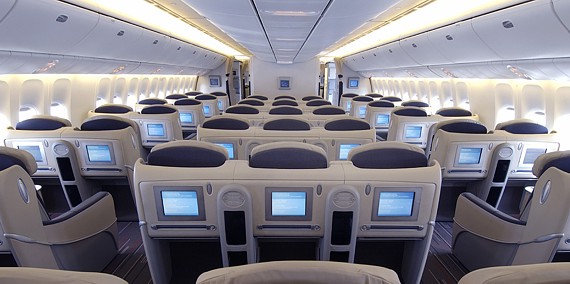Modern airplanes are marvels of technology. Yet when they crash, as two have in the past month, investigators often must hunt for the recordings of the flight data and pilot communications since these "black boxes" are located on the plane. Both the June 1 Air France and June 30 Yemenia Airways Airbus crashes happened over water; in both cases, the boxes are thought to sit at major depths, not easily recoverable. Which prompts an obvious question: Why are such data even stored on the airplane? Isn't it more logical to transmit it to a land-based receiver, where it could be accessed quickly in a crash investigation?
The answer, say flight data experts, is "Yes, but…" Yes, most of the technology exists to send flight data and voice from commercial airplanes. But the cost remains so immense no one would fund it. Moreover, such a change would not address any safety issues—and safety almost always takes priority in spending decisions by airlines and regulators.
"The volume of information you're talking about is infeasible in terms of what it would cost to do that for every airplane," says Ray Oishi, a senior engineering fellow at Annapolis (Md.)-based ARINC, which transmits texts and other data for airline customers. Airlines would also discard virtually all the routine data that were sent, Oishi notes. "Just because it's imaginable doesn't mean it's practicable."
Another factor is that black boxes are nearly always recovered. In the past few decades, only the two jets that crashed on September 11 at the World Trade Center lost their flight data and voice recorders, industry officials say.
But it's possible that the Air France Flight 447 crash will add to that short list of unrecovered boxes. July 2 marked the end of the 30-day period during which the Air France devices were expected to transmit a useful locator beacon. Nonetheless, French investigators say they will extend their search until July 10. France has mounted a significant naval expedition some 900 miles northeast of the Brazilian coast, deploying ships and listening devices to locate the boxes. The jet appears to have struck the sea at high speed and intact, based on inspection of wreckage debris, French authorities said.
Investigators already have more than a dozen automatic data transmissions the Airbus A330 sent shortly before it was lost, and those signaled various operational problems. However, without the sophisticated data stored aboard the plane—25 hours of data on 88 flight parameters plus the final two hours of cockpit audio—the investigation will remain hampered. Ultimately, a mystery around an air disaster could also provide fresh impetus for finding a different system. Says Dan Elwell, vice-president of civil aviation for the Aerospace Industries Assn., a trade group representing airplane and component builders: "At some point we'll look back and remember when we sent divers down in the water."
Seven years ago, L-3 Aviation Recorders (LLL), the largest maker of flight data recorders, partnered with a satellite company to study the cost of moving to a flight-data transmission system. The exercise assumed a 50% reduction in future satellite transmission costs. But even that cost proved to be prohibitive: $300 million annually for a U.S. carrier flying a global network. "And that doesn't even address other hardware costs," says Bruce Coffey, president of the L-3 recorder unit, which is based in Sarasota, Fla. That compares with the $20,000 cost for on-board data and voice recorders, which are certified for 100,000 flight hours, or about 30 years. That essentially makes the boxes a one-time expense for an airline, Coffey says.
Yet many in the field expect that someday flight data and pilot communications will be beamed from airplanes, as transmission, computing, and storage costs continue to fall. "I don't think it's going to happen in my career," says Coffey, 52. "Change occurs very slowly in this industry," he said. "I think eventually if satellite transmission rates become affordable, then…you will have some operators looking at this." He expects transmission will ultimately become standard.
Elwell, with the AIA, says fuel costs will also factor into the math for airlines. Each box weighs roughly 10 pounds…a minor load except when calculated across a growing global air fleet in an era when fossil fuel costs are likely to rise. "At some point it will be cheaper to transmit the information off-ship and store it than the gas you burn to haul the…box," Elwell says.
The National Transportation Safety Board, which investigates U.S. airline incidents and recommends regulatory changes to the Federal Aviation Administration, has not taken a position on flight data or voice-recorder transmissions. Neither agency is pursuing the issue.
As for finding such boxes in the deep oceans, mapping sonar is one potential aid. The French investigative authority, BEA, has sought information from C & C Technologies, a Lafayette (La.) outfit that operates underwater sonar vehicles for oil companies, shipwreck exploration, and other deep-sea work. A search of the area using that equipment would cost as much as $90,000 per day, C & C president and CEO Thomas Chance said. C&C's "autonomous underwater vehicles" transmit low-frequency sonar to map undersea terrain. If an object needing further inquiry is spotted, high-frequency signals provide a more detailed read. The vehicle also has a camera. "We're ready to go if they ever decide to call us," Chance said Thursday
Until they're found, the missing boxes leave uncertainty about whether a safety problem exists for other Airbus planes. And the lack of crash details adds to the pain of those who lost loved ones. Marco Tulio Moreno Marques, a Brazilian attorney who lost his parents in the Air France crash, told the Associated Press on July 2: "They can say a flying saucer hit the plane, but if they don't find the black boxes we will never know for certain what happened."




No comments:
Post a Comment